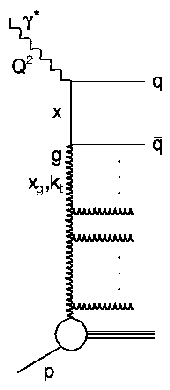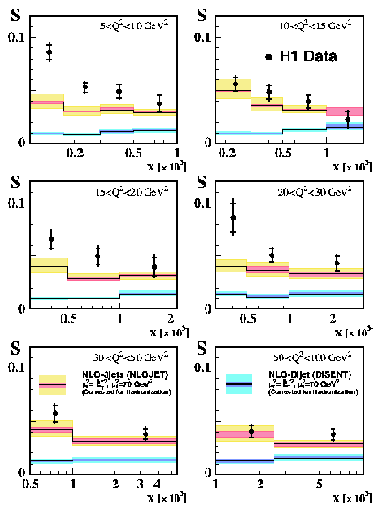back to overview of this paper
Inclusive Dijet Production at Low Bjorken-x
in Deep Inelastic Scattering
|
 Understanding the parton densities of the proton and how they evolve
with kinematic variables
at low values of the
Bjorken variable x
has been a major theme of HERA physics and QCD in recent times.
The evolution of the parton densities with the
factorization scale, µ²,
is generally described by the DGLAP equations.
To leading logarithmic accuracy, this is equivalent to the exchange of a parton
cascade (see figure on the
right), with the exchanged partons strongly ordered in virtuality up
to Q², the modulus of the
squared four momentum of the photon exchanged in the ep scattering.
The DGLAP approximation is, however, expected to break down at low
x, as it only resums leading
logarithms in Q²
and neglects contributions from
log (1/x) terms, which are
present in the full perturbative expansion.
Understanding the parton densities of the proton and how they evolve
with kinematic variables
at low values of the
Bjorken variable x
has been a major theme of HERA physics and QCD in recent times.
The evolution of the parton densities with the
factorization scale, µ²,
is generally described by the DGLAP equations.
To leading logarithmic accuracy, this is equivalent to the exchange of a parton
cascade (see figure on the
right), with the exchanged partons strongly ordered in virtuality up
to Q², the modulus of the
squared four momentum of the photon exchanged in the ep scattering.
The DGLAP approximation is, however, expected to break down at low
x, as it only resums leading
logarithms in Q²
and neglects contributions from
log (1/x) terms, which are
present in the full perturbative expansion.
At very low values of x, it
is believed that the theoretically most appropriate description is
given by the BFKL evolution equations. These resum large logarithms of 1/x
up to all orders and impose no
restriction on the ordering of the transverse momenta within the parton
cascade. To account for the possibly significant transverse momentum of
the incoming parton to the hard scatterng,
off-shell matrix elements have to be used together with
an unintegrated gluon distribution function, which depends on the parton
pT as well as the usual x and Q2 variables.
A promising approach to parton evolution at both small and large values of
x is given by the CCFM evolution
equation, which, by means of angular-ordered parton emission, is
equivalent to the BFKL ansatz for x -> 0, whilst reproducing the DGLAP
equations at large x.
Dijet data may be used to gain insight into the
dynamics of the parton cascade typically exchanged in
low-x lepton-proton interactions.
In the low x region, the gluon density becomes very large
and photon-gluon fusion is the dominant
underlying process for dijet production. Such measurements are thus
sensitive to the dynamics of the parton cascade and the unintegrated gluon
distribution.
The measurement presented in this paper is based on data
collected with the H1 detector at HERA during the years 1996 and 1997
and covers the kinematic region of
5 < Q² < 100 GeV² and
10-4 < x < 10-2. At least
two jets with transverse energies of
E_T > 7 GeV and E_T > 5 GeV, well measured with
the H1 Liquid Argon Calorimeter, are required.
Dijet cross sections are measured as a function of x, Q², E_T and the
pseudorapidity distance between the jets. The results are
compared with QCD dijet calculations at next-to-leading-order. Within the
uncertainties, good agreement between the data and the theoretical
predictions is observed, even in regions where effects due to small-x
dynamics should be most prominent.
More insight into small-x dynamics
can be gained from the dijet data by studying the behaviour of
events with a small azimuthal separation, Delta_phi, between the
two highest transverse momentum jets. Partons entering the hard scattering
process with negligible transverse momentum, as assumed in the DGLAP
formalism, lead at leading order of QCD to a
back-to-back configuration of the two outgoing jets with
Delta_phi=180°. Azimuthal jet separations different from 180°
occur due to
higher order QCD effects. However, in models which predict a
significant proportion of partons entering the hard process with large
transverse momentum, the number of events with
small Delta_phi also increases.
In order to search for such effects,
we present a measurement of the ratio

of the number of events N_dijet
with an azimuthal jet separation of Delta_phi < 120° relative to all
dijet events. The result of the measurement is shown in the following
figure as a function of x for different
regions in Q².

The fraction of jets with an azimuthal separation
Delta_phi < 120° is of the order of of 5% and increases with
decreasing x. This rise is most prominent in the lowest Q²
interval, where the smallest
values of x are reached. The
NLO dijet QCD calculations predict S values of only ~1% and show no rise
towards small x. The data are also compared with an NLO calculation for
3-jet production, corresponding to an extra order in the strong coupling
constant alpha_s for the perturbative calculation. The 3-jet calculation
is closer to the data and shows the correct qualitative features. However, it
is still insufficient to describe the magnitude of S at the lowest x and
Q2 values, suggesting that further improvements to the theory
are required.
The data are also compared
with the predictions of the CASCADE Monte Carlo
program (not shown here), which includes CCFM evolution and unintegrated
parton densities. The predictions are found to be highly sensitive to the
choice of unintegrated gluon density, with different parameterisations that
descibe the proton structure function F2 yielding rather
different predictions for S. One of the unintegrated gluon parameterisations
(J2003) describes the S data rather well. Hence, the S observable has
a strong potential to constrain the unintegrated parton densities.
back to overview of this paper
 Understanding the parton densities of the proton and how they evolve
with kinematic variables
at low values of the
Bjorken variable x
has been a major theme of HERA physics and QCD in recent times.
The evolution of the parton densities with the
factorization scale, µ²,
is generally described by the DGLAP equations.
To leading logarithmic accuracy, this is equivalent to the exchange of a parton
cascade (see figure on the
right), with the exchanged partons strongly ordered in virtuality up
to Q², the modulus of the
squared four momentum of the photon exchanged in the ep scattering.
The DGLAP approximation is, however, expected to break down at low
x, as it only resums leading
logarithms in Q²
and neglects contributions from
log (1/x) terms, which are
present in the full perturbative expansion.
Understanding the parton densities of the proton and how they evolve
with kinematic variables
at low values of the
Bjorken variable x
has been a major theme of HERA physics and QCD in recent times.
The evolution of the parton densities with the
factorization scale, µ²,
is generally described by the DGLAP equations.
To leading logarithmic accuracy, this is equivalent to the exchange of a parton
cascade (see figure on the
right), with the exchanged partons strongly ordered in virtuality up
to Q², the modulus of the
squared four momentum of the photon exchanged in the ep scattering.
The DGLAP approximation is, however, expected to break down at low
x, as it only resums leading
logarithms in Q²
and neglects contributions from
log (1/x) terms, which are
present in the full perturbative expansion.

